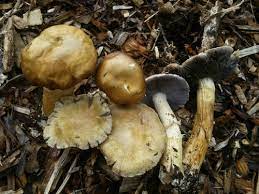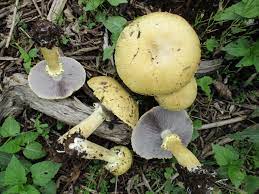Golden Wine Cap Stropharia Rugosoannulata
Golden Wine Cap Stropharia rugosoannulata, commonly referred to as Golden Wine Cap, Garden Giant or King Stropharia, is a mushroom commonly found growing among beds of wood chip mulch. This fungus is considered a saprotroph and provides protein which benefits other vegetable species in the garden.
Young wine cap stropharia have intense reddish-purple caps and purple-gray gills. As they mature, these gills form a wrinkled ring or annulus around their stem.
Cap Color
The Golden Wine Cap Stropharia rugosoannulata is an edible mushroom native to northern climate zones that has gained notoriety for its high nutritional content, pleasant taste and bioactive compounds derived from its fruiting body. It has become one of the top ten edible mushrooms worldwide traded internationally and even recommended by FAO for exportation to developing countries 
The caps start out dark burgundy, but eventually turn to a straw-colored or tan hue as they mature. The gills become increasingly crowded and attached to the stem as they mature; starting as white and changing to purple/black in maturity.
Mushrooms are often grown in home gardens to provide essential nutrients for the soil as well as an edible source of protein. They can grow on a variety of substrates such as straw, sawdust or wood chips.
They’re often employed in cooking, with braising or grilling being two popular options. You can roast or stuff pumpkins to serve alongside other fall veggies in dishes, or add flavor to meat sauces, soups, and risotto dishes.
These mushrooms are not only delicious to eat, but they’re also packed full of protein, fiber and vitamins as well as minerals like potassium and magnesium. Vegetarians and vegans especially should consider including mushrooms in their diet as they provide essential nutrients and antioxidants that could potentially prevent cancer or heart disease.
Stropharia rugosoannulata, in addition to being an edible mushroom, also has beneficial effects on soil and bacterial communities in forestlands. Cultivating this mushroom led to consistent increases in organic matter and available phosphorus, as well as greater bacterial diversity and alpha diversity.
The Golden Wine Cap Stropharia rugosoannulata mushroom is an edible species cultivated for centuries in China. It provides vital protein, fiber and bioactive compounds like polysaccharides and steroids – making it a highly valuable food resource that can be grown with minimal labor and resources in either commercial or small-scale settings.
Gills Color
Golden Wine Cap Stropharia rugosoannulata’s gills range in color from purple to dark purple, depending on how many spores they contain. They’re attached to a stem which begins as cream or white when young but changes to yellow-brown as the mushroom matures.
These mushrooms are distinctive for their wrinkled rings around their stems. This radially wrinkled ring is what gives these mushrooms their scientific name – rugosoannulata comes from Greek strophos, meaning belt, and adds the suffix -annulata, meaning wrinkled or creased, as this ring wrinkles as it travels down its stem.
 These mushrooms typically grow medium to large, with caps ranging in size from 6-13 centimeters across. Their stems may be long and wide – up to six inches depending on species – though usually less than that.
These mushrooms typically grow medium to large, with caps ranging in size from 6-13 centimeters across. Their stems may be long and wide – up to six inches depending on species – though usually less than that.
Mushroom stems are thick and stiff, with their gills attached near the base. These thin, papery gills aid in spore dispersal.
Gill fungi, such as those seen in the image at left, produce spores on their surface – some species release over 1,000,000,000 per day! Spores are minute particles inside mushrooms that help distinguish different species.
Spore prints can be made by placing the cap of a mushroom, gills down, on paper. This is an effective way to identify gill fungi since the color of their spores varies between species.
When inspecting a gill fungus, one important feature to look for is its pores. These appear as small holes on the underside of the mushroom’s cap and vary in distance from each other. Some gill fungi have pores located close to their base while others are farther away.
In most gill fungi, the pore is more visible than the spores. However, in certain species, this pore may be obscured by their own gills.
If you’re uncertain of the species of mushroom you are viewing, try to assess its gill shape, distance from the cap, and thickness. Some gills have a pointed base while others are flat and smooth. Other features that can help identify a mushroom species include color of the gills or shape of the cap.
Stalk Color
Stropharia rugosoannulata, commonly known as the golden wine cap, is an inconspicuous fungus that can be found in many places. Urban settings usually feature beds of wood chips and mulch, while suburban landscaped areas may also harbor them.
Mushrooms are relatively straightforward to grow and produce generous harvests. Furthermore, they add valuable nutrients into the soil as well as aiding with weed suppression in garden beds.
Nematophagous fungi, these mushrooms have the power to break down harmful worms that could harm plants. Their fruiting bodies range in diameter from several inches up to 40 centimeters.
These caps of this fungus can be wine-red or straw-colored when young, but darken to dark brownish shades as they mature. They attach to long, thick stems that can reach twenty centimeters in length. The gills beneath the cap start out pale but eventually turn grey and purple as they mature.
When young, a partial veil covers the gills; however, as the mushroom matures it breaks away to reveal an annulus-shaped ring around its stem. The spore print for this species is white and ellipsoid in shape with a germ pore measuring 10-13 x 7.5-9 microns in dimension.
Agrocybe species can be mistaken for several other Agaricus species due to their pinkish-purple gills and chocolate-brown spore prints. Furthermore, Agrocybe does not usually deposit a reddish-purple hue on its caps nor produce wrinkled rings like King Stropharia does.
Another distinct difference is that King Stropharia can grow to be quite large, reaching up to eight inches high and one foot across, while Agrocybe species typically produce fruiting bodies which are much smaller. Therefore, for those interested in trying a different kind of fungus, King Stropharia makes an ideal choice as it’s easily available and resistant to common problems associated with fungi.
These mushrooms are best enjoyed when in their button stage, when they’re tender and flavorful. Harvest them before their gills become dark with spores or before the veil separates from the stalk; once removed, these mushrooms can be used for sauteeing or as a replacement for portobello mushrooms.
Spore Print
The Golden Wine Cap Stropharia rugosoannulata is one of the easiest mushrooms to cultivate and produces large harvests. It’s often referred to as “garden giant,” making it one of the world’s most beloved fungi.
This mushroom is an ideal starting point for gardeners, as it is easy to cultivate, produces large harvests and costs little. It belongs to the Stropharia family of saprophytic fungi which break down dead and decaying organic matter.
Mushroom identification: this mushroom can often be found in wood chips or urban areas. However, be mindful that some fungi can be difficult to spot as they blend in with their environment, so be diligent when searching for them.
To identify a wild mushroom, the easiest way to do so is by making its spore print. This step is essential in the identification process and also an excellent opportunity to learn more about fungi as different species’ spores may vary in color.
To create a spore print, cut off the stalk of the mushroom and lay it gill side down on paper or glass. Tin foil works best as this is sterile and won’t attract airborne spores. Once covered, leave for 6-12 hours.
Tin foil works best as this is sterile and won’t attract airborne spores. Once covered, leave for 6-12 hours.
Once the spores have fallen to paper, remove the cap and allow to air-dry for a couple of hours. Any residual moisture can lead to bacteria formation – not what you want when growing magic mushrooms!
After drying, the mushroom spore print should be stored in a cool and dark location. For optimal protection, store it inside a self-sealing bag with oxygen and moisture absorbing satchels for extra security.
Spores are fungal seeds that disperse into the air and search for a suitable habitat. Once they settle down, they can begin to develop into mycelium and produce fruits. Alternatively, these spores may serve as genetic material for other fungal species.
